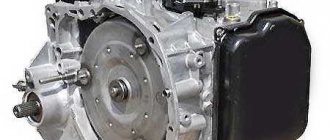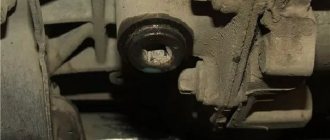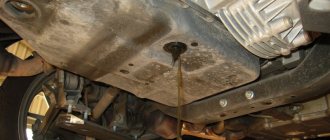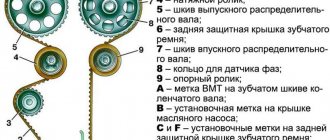An automatic gearbox (automatic transmission) makes driving a car much easier. But despite the ease of use, the “automatic” still has several drawbacks, the main one of which was and, perhaps, will be the high cost of repairs. Therefore, it is necessary to properly maintain the unit and regularly change transmission fluid. Changing the automatic transmission oil in a timely manner will help you avoid all sorts of problems with gear shifting and, as a result, high repair costs.
Replacement frequency
Important! The average transmission oil change interval is 80-90 thousand km, but exact data can be found in the passport of a specific car model.
If the vehicle is operated in harsh conditions, such as in the desert or in dusty areas, the oil change interval will be reduced. Official dealers recommend replacing it much more often - this will extend the life of the gearbox. Of course, we are talking about domestic dealers and the impact of Russian roads on the components and assemblies of the car.
When to change automatic oil
Taking into account all factors, we can conclude that the optimal period for replacing transmission fluid on automatic transmissions is a mileage of 60-80 thousand km. Such an interval will reduce the risks for automatic transmission.
How long does it take to change the oil in an automatic transmission?
Substitution nuances in different brands
Most automakers do not provide for the possibility of changing automatic transmission oil, adding fluid for the entire period of operation of the vehicle. On average, this implies from 150 to 250 thousand kilometers. But, according to the recommendations of experts, complete or partial replacement should be carried out every 60,000 kilometers.
Much depends on the specific car model. Let's look at the features that should be taken into account when changing the oil on certain cars from large automakers. Using their example, we will see what difficulties motorists face when carrying out this procedure at home.
The nuances of changing transmission oil on some models:
- Kia Rio III/IV, Hyundai Solaris I, II: These cars, depending on the year of manufacture, have a 4 or 6-speed automatic transmission. The official regulations indicate the need to change the oil every 90 thousand kilometers, while experts indicate the figure at 60 thousand.
- The regulations state that there is no need to change the transmission lube filter - its service life is enough for 120 thousand kilometers. Specialists from car service centers do not agree with this and indicate a figure of 60 thousand kilometers.
- For a 4-speed automatic transmission, it is recommended to buy ATF SP-III oil, and for a 6-speed automatic transmission - ATF SP-4.
- Most of these models have a 6-speed automatic transmission, which is a maintenance-free part with a safety margin of 250 thousand kilometers. But in order for it to last that long, it is recommended to carry out at least a partial replacement of the transmission lubricant every 60-70 thousand kilometers or more often.
- These models are equipped with 6-speed automatic transmissions Gm 6T40, 6T45 and 6T30. The safety margin of these parts is 120-150 thousand kilometers. Partial oil changes also occur every 35,000-50,000 kilometers.
- This model is equipped with a 5-speed automatic transmission FNR5, for which, according to official regulations, maintenance is not even provided. Only major repairs every 150-200 thousand kilometers. But here, too, the recommendations of experts are different. According to their opinion, a partial oil change in this automatic transmission should be carried out at least once every 50-60 thousand kilometers.
The examples above show that when changing the oil in an automatic transmission, each brand has its own nuances. And they need to be taken into account when consulting with specialists, for example, at car services.
When should you change your oil?
Some problems in the operation of the automatic transmission may be signs of a low level or poor quality fluid. Here are the most common ones:
- low oil pressure in the box;
- when changing gears the car slips;
- on a long climb at the last speed, the automatic transmission slips and switches to a lower gear;
- the car does not move - neither backwards nor forwards;
- the box does not switch from P or N mode to any speed;
- When you turn on any speed, there is a jolt, the gear is engaged, but the car does not move.
Types of automatic transmission oil
Each of the problems described may have other causes. For example, low pressure in the box may not only be due to a decrease in oil level. This can also be affected by a failed relief valve in the oil pump. It is worth noting that when the valve body becomes dirty, the pressure also decreases.
Low pressure in automatic transmission
Draining oil through the plug
Let's merge! If your box has a drain plug at the bottom, first place some large container under it. Usually, its role is played by cut-off plastic canisters, taking into account that several liters of fluid will come out of the transmission (about 3 to 5). Next, unscrew this drain plug and oil will flow out of the neck by gravity. And now you just have to wait until all the liquid that can leak out, accordingly, flows out. After this, screw the drain plug back on. Count the amount of oil drained from the transmission - you will now need to pour the same amount of new fluid inside.
Does the automatic transmission kick and jerk when changing gears? Check the valve body.
Instructions for changing automatic transmission oil
Before you begin the replacement, you need to prepare everything for work. First of all, you need to purchase high-quality transmission fluid. You will also need a container to drain the oil and work gloves. So, let's go!
Changing the automatic transmission oil
Step 1: First check the transmission fluid level using the dipstick. Automatic transmission fluid is colored red or green to differentiate it from engine oil and other fluids in your vehicle. On most cars, you can check the level with a dipstick while the engine is running.
Checking the transmission fluid level
Step 2: Secure the vehicle's wheels using wheel chocks or bricks.
Car wheel lock
Step 3. Raise the car using jacks and place it on special supports. Make sure you have enough room to squeeze under the car and that the jacks are secure.
Installing the vehicle on supports
Step 4: Always park on a flat, level surface when working under a vehicle, and use jack stands, chucks, or other suitable support to ensure safety in the event the jack fails or the vehicle attempts to roll off the ramp.
The machine must be on a level surface
Step 5: Locate the transmission fluid pan. The pan will be attached to the bottom of the transmission with 6-8 bolts, so you will have to crawl under the car to find it.
Transmission pan
Step 6. Place a container under the drain hole. Inexpensive plastic containers can be purchased at most auto supply stores.
Special container for draining oil
Step 7: Remove the bolt from the drain hole to drain the transmission fluid.
Draining transmission fluid
Step 8. If there is no drain hole (this can also happen), then to drain the fluid you need to unscrew the gearbox cover. It is likely that some liquid will get on your hands, as it is almost impossible to avoid.
Removing the automatic transmission cover
Step 9: Inspect the leaking fluid. Most automatic transmission pans have a magnet inside to collect metal shavings caused by worn moving parts. Remove the shavings along with any remaining liquid in the pan. Metal shavings are normal and represent typical gear wear. However, large or irregularly shaped pieces are not normal.
Inspecting the oil for metal shavings
On a note! When drained, about 50 percent of the fluid will remain in the gearbox. To remove all fluid, including torque converter fluid, the transmission must be flushed completely, a process that is usually part of a comprehensive maintenance routine.
Step 10: Inspect the transmission fluid filter and gaskets. When replacing the fluid, it is recommended to check their condition and replace if necessary.
Checking the condition of the pan gasket
Step 11. Fill in new transmission fluid using a watering can for convenience. On most cars, oil is poured through the neck in which the dipstick is located. You can find out the correct amount of liquid in the operating instructions.
Adding fresh oil to the automatic transmission
Step 12: Start the engine and let it run for a few minutes. Then check the fluid level. If the level is low, add some oil. Be careful not to overfill!
Starting the engine after changing the oil
Some automatic transmissions require checking the fluid in mode N, while others require checking in mode P. The marks on the dipstick will help you fill in the right amount of oil.
Complete oil change
To completely change the fluid, special equipment is required that is connected to the automatic transmission system. This procedure takes place in 3 stages:
- At the first stage, the entire automatic transmission system is completely washed with a special fluid.
- At the second stage, the used oil is replaced with a new one using the displacement method. The old oil replaces the new one, and thus it is completely eliminated.
- At the third stage, change the filter and pan gaskets.
The advantages of this method are that it reduces gasoline consumption, significantly reducing losses in hydroformat. In addition, since the oil change is carried out under strong pressure, the entire gearbox system is practically completely cleaned; used oil and any deposits are not retained in it. Of course, a complete fluid change is much more expensive than a partial one, but the normal operation of the box is guaranteed after it.
Additional recommendations
Dispose of liquid properly. Transmission fluid is harmful to the environment, so it is important to avoid draining oil into the environment. Changing the transmission fluid can extend the life of the transmission, so replacement is necessary even if the fluid is still red after a certain mileage has been reached.
If you don't change the oil in the automatic transmission
Note! If the fluid is dark red or brown in color and smells like burning, the transmission needs to be flushed completely. The transmission may be seriously damaged.
We hope our recommendations helped you with changing the transmission oil. Share your experience below in the comments!











